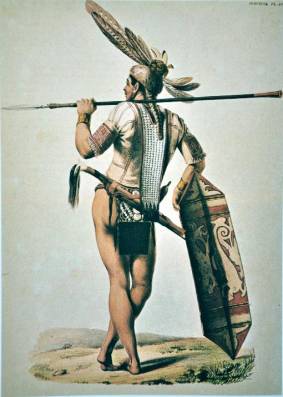Ngaju people
Appearance
You can helpexpand this article with text translated fromthe corresponding articlein Indonesian.(November 2014)Click [show] for important translation instructions.
|
 An illustration of a Dayak Ngaju warrior. | |
| Total population | |
|---|---|
| 400,000 | |
| Regions with significant populations | |
| Central Kalimantan | 324,504 (2000)[1] |
| Languages | |
| Ngaju language,Bakumpai language,Indonesian language | |
| Religion | |
| Christianity(Protestant Christian&Catholicism) 44%,Islam(Sunni) 43%,Kaharingan13%[2] | |
| Related ethnic groups | |
| Dayak people(Bakumpai people,Meratus Dayak) | |
TheNgajupeople (alsoNgaju DayakorDayak NgajuorBiaju) are an indigenous ethnic group ofBorneofrom theDayakgroup.[3]In a census from 2000, when they were first listed as a separate ethnic group, they made up 18.02% of the population ofCentral Kalimantanprovince. In an earlier census from 1930, the Ngaju people were included in theDayak peoplecount.[4]They speak theNgaju language.
Subgroups[edit]

Based on river stream regions, the Ngaju people are divided into:-
- Greater Batang Baiju - Greater Baiju River
- Lesser Batang Baiju - Lesser Baiju River
Based on language, the Ngaju people are divided into:
- Dayak Ngaju (Ngaju Kapuas)
- Dayak Kahayan (Ngaju Kahayan)
- Dayak Katingan (Ngaju Katingan)
- Dayak Mendawai (Central Kalimantan)
- Dayak Bakumpai(South Kalimantan)
- Dayak Meratus(South Kalimantan)
- Dayak Mengkatip (Central Kalimantan)
- Dayak Berangas (South Kalimantan,which is said to be no longer identifiable and their language is no longer in existence as of 2010 due to assimilation into the mainstream KualaBanjar people)
- Dayak Beraki (Bara-ki; no longer in existence)[5]
Culture[edit]
Traditional folk songs[edit]
Food[edit]
- Kopu, fermented cassava root. Usually eaten by mixing with shredded coconut meat[9][10]
- Karuang or Kalumpe by theMa'anyan people,a poundedCassavaleaf salad mixed with eggplant, lemongrass, onion and garlic.[10]
- Juhu Umbut Batang Undus, coconut sprout salad eaten withsambaland often served during thanksgiving or wedding ceremonies.[10]
Notable Dayak Ngaju people[edit]
- Hausman Baboe,a prominent figure in theCentral Kalimantanpress and founder of the first dailySuara DayakIndonesian newspaper.
- Tjilik Riwut,aNational Hero of Indonesia,founder ofCentral Kalimantan,a writer, aCentral Kalimantanfreedom fighter and former governor ofCentral Kalimantan.
See also[edit]
References[edit]
- ^Badan Pusat Statistik - Sensus Penduduk Tahun 2000
- ^Chalmers, Ian (2006). "The Dynamics of Conversion: The Islamisation of the Dayak Peoples of Central Kalimantan". In Vickers, A.; Hanlon, M. (eds.).Proceedings of the 16th Biennial Conference of the Asian Studies Association of Australia (ASAA): Asia Reconstructed, Jun 26–29 2006.Wollongong, NSW: Australian National University.hdl:20.500.11937/35283.
- ^Leo Suryadinata, Evi Nurvidya Arifin & Aris Ananta (2003).Indonesia's Population: Ethnicity and Religion in a Changing Political Landscape.Institute of Southeast Asian Studies.ISBN981-230-212-3.
- ^Riwanto Tirtosudarmo (2007).Mencari Indonesia: Demografi-Politik Pasca-Soeharto.Yayasan Obor Indonesia.ISBN978-979-799-083-1.
- ^M. J. Melalatoa (1995).Ensiklopedi Suku Bangsa Di Indonesia, Volume 1.Departemen Pendidikan dan Kebudayaan RI.OCLC37396203.
- ^"lagu dayak Erika sinta takalupe lunuk".Rocky wans.Retrieved2015-08-05.[dead YouTube link]
- ^"Karungut Kal-Teng Membangun (karungut modern)".tingang.Retrieved2015-08-05.[dead YouTube link]
- ^Pak Siswa 2 Ktsp-revisi (tuhan Mengasihi Semua Orang).BPK Gunung Mulia. 2007.ISBN978-979-687-591-7.
- ^Iwan Prasetya (22 June 2013)."Nikmatnya Daging Paing, Kelelawar Raksasa Khas Kalteng".Liputan6. Archived from the original on November 5, 2016.Retrieved2016-11-05.
{{cite web}}:CS1 maint: unfit URL (link) - ^abcFebria Silaen (20 May 2016)."Sederet kuliner khas Kalimantan Tengah".Beritagar.Retrieved2016-11-05.
Wikimedia Commons has media related toNgaju people.
